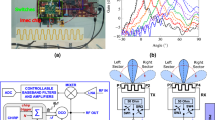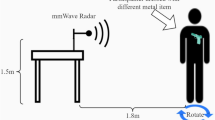Abstract
Human body recognition is widely used in smart home. The current mainstream perception modalities, i.e., camera and wearable device, are vulnerable under challenging lighting conditions and poor convenience. On the other hand, Multi-human body recognition remains as one of the most challenging tasks in a dynamic and complex environment. In this work, we introduce the low-cost multiple-input-multiple-output (MIMO) millimeter-wave radar without exposing user’s private information for human body recognition in smart home. We propose a human body recognition scheme with the clustering based on the human body tracking using the sparse point cloud data of MIMO millimeter-wave radar. Firstly, the possible position of human body is predicted based on Kalman filter. Then, the point cloud data is clustered based on the human body shape in the prediction range of the human position. Finally, label tags are used to mark the human body targets detected by each frame of the radar. We apply human body recognition to validate the effectiveness of the proposed scheme. It can achieve single-person and double-person recognition using the sparse point cloud data of MIMO millimeter-wave radar. The results show that our proposed scheme reduces the error probability by 23.4% for the single-person recognition and by 31.1% for the double-person recognition. Extensive evaluations on the application of human activity recognition well demonstrate the practicability of the proposed scheme.













Similar content being viewed by others
References
Abramovich YI, Frazer GJ, Johnson BA (2013) Principles of modeSelective MIMO OTHR. IEEE Trans Aerosp Electron Syst 46(3):1839–1868
Banan A, Nasiri A, Taheri-Garavand A (2020) Deep learning-based appearance features extraction for automated carp species identification. Aquac Eng 89:102053–102053
Chalabi NE, Attia A, Bouziane A, Akhtar Z (2021) Particle swarm optimization based block feature selection in face recognition system. Multimedia Tools Appl 80:33257–33273
Clemente C, Pallotta L, Maio AD, Soraghan JJ, Farina A (2015) A novel algorithm for radar classification based on doppler characteristics exploiting orthogonal Pseudo-Zernike polynomials. IEEE Trans Aerosp Electron Syst 51(1):417–430
Erol B, Amin MG, Boashash B, Ahmad F, Zhang YD (2016) Wideband radar based fall motion detection for a generic elderly. 50th Asilomar Conference on Signals. Systems and Computers
Fan Y, Bao J, Aljumaily MSL, Li H (2019) Communications via frequency-modulated continuous-wave radar in millimeter wave band. IEEE Global Communications Conference
Gurbuz SZ, Clemente C, Balleri A, Soraghan JJ (2017) Micro-Doppler-based in-home aided and unaided walking recognition with multiple radar and sonar systems. IET Radar Sonar Navig 11(1):107–115
Hai D, Himed B (2009) A Virtual Antenna Beamforming (VAB) approach for radar systems by using orthogonal coding waveforms. IEEE Trans Antennas Propag 57(2):425–435
Ji Y, Yang Y, Xu X, Shen HT (2018) One-shot learning based pattern transition map for action early recognition. Sig Process 143(1):364–370
Ji XP, Cheng J, Feng W, Tao DP (2018) Skeleton embedded motion body partition for human action recognition using depth sequences. Sig Process 143(1):56–58
Jin F, Sengupta A, Cao SY, Wu YJ (2020) MmWave radar point cloud segmentation using GMM in multimodal traffic monitoring. IEEE International Radar Conference
Jiang X, Zhang Y, Yang Q, Deng B, Wang H (2020) Millimeter-wave array radar-based human gait recognition using multi-channel threedimensional convolutional neural network. Sensors 20(19):5466–5466
Jokanović B, Amin M (2018) Fall detection using deep learning in range-doppler radars. IEEE Trans Aerosp Electron Syst 54(1):180–189
Laura G, Jiménez JM, Miran T, Jaime L (2018) Wireless technologies for IoT in smart cities. Netw Protoc Algorithm 10(1):23–64
Laura G, Lorena P, Miran T, Jaime L (2018) System for detection of emergency situations in Smart City Environments Employing Smartphones. In: 2018 International Conference on Advances in Computing, Communications and Informatics (ICACCI), pp 266–272
Liang L, Popescu M, Skubic M, Rantz M, Cuddihy P (2011) Automatic fall detection based on Doppler radar motion signature. In: 2011 5th International Conference on Pervasive Computing Technologies for Healthcare, pp 222–225
Markopoulos PP, Zlotnikov S, Ahmad F (2019) Adaptive radar-based human activity recognition with L1-Norm linear discriminant analysis. IEEE J Electromagn Rf Microwaves Med Biol 3(2):120–126
Pham C, Nguyen L, Nguyen A, Nguyen N, Nguyen VT (2021) Combining skeleton and accelerometer data for human fine-grained activity recognition and abnormal behaviour detection with deep temporal convolutional networks. Multimedia Tools Appl 80(19):28919–28940
Qian K, He ZY, Zhang XY (2020) 3D Point cloud generation with millimeter-wave radar. Proc ACM Interact Mob Wearable Ubiquitous Technol 4(4):1–23
Ricci R, Balleri A (2015) Recognition of humans based on radar micro-doppler shape spectrum features. Sonar Navig IET Radar 9(9):1216–1223
Schumann O, Hahn M, Dickmann J, Wöhler C (2018) Semantic segmentation on radar point clouds. 21st International Conference on Information Fusion, pp 2179–2186
Varshney N, Bakariya B, Kushwaha AKS (2022) Human activity recognition using deep transfer learning of cross position sensor based on vertical distribution of data. Multimedia Tools Appl 81:22307–22322
Wan EA, Van der Merwe R, Nelson AT (2000) Dual estimation and the unscented transformation. Advances in Neural Information Processing Systems. NIPS 1999, pp 666–672
Wang M, Zhang YD, Cui G (2019) Human motion recognition exploiting radar with stacked recurrent neural network. Digit Signal Proc 87(2):125–131
Wang M, Cui G, Yang X, Kong L (2018) Human body and limb motion recognition via stacked gated recurrent units network. IET Radar Sonar Navig 12(9):1046–1051
Wei L, Yang X, Chao Z, Shuai L, Ning L (2016) DRFM range false target cancellation method based on slope-varying LFM chirp signal. In: 2016 IEEE 13th International Conference on Signal Processing (ICSP)
Zhai W, Zhang Y (2014) Motion parameters estimation of high-speed moving target for stepped frequency chirp signal. In: 2014 International Radar Conference
Zhu SY, Xu JH, Guo HQ, Liu QW, Wu SE, Wang HG (2018) Indoor human activity recognition based on ambient radar with signal processing and machine learning. In: 2018 IEEE International Conference on Communications, pp 1–6
Acknowledgements
This work is granted by the Science and Technology Department of Jilin Province, China [Grant No. 20220101153JC]. Some or all data during the study are available from the corresponding author by request (Email: tjguo_ciomp@hotmail.com). Authors express their gratitude to IoT Innovation Lab at UTS in Australia for their generously provided the experimental equipment. Authors would also like to thank anonymous reviewers and editors provided many helpful comments on the manuscript.
Author information
Authors and Affiliations
Corresponding author
Ethics declarations
Conflict of interest
The authors declare that they have no conflict of interest.
Additional information
Publisher’s note
Springer Nature remains neutral with regard to jurisdictional claims in published maps and institutional affiliations.
Rights and permissions
Springer Nature or its licensor (e.g. a society or other partner) holds exclusive rights to this article under a publishing agreement with the author(s) or other rightsholder(s); author self-archiving of the accepted manuscript version of this article is solely governed by the terms of such publishing agreement and applicable law.
About this article
Cite this article
Zhou, X., Meng, X., Zheng, J. et al. Human body recognition based on the sparse point cloud data from MIMO millimeter-wave radar for smart home. Multimed Tools Appl 83, 22055–22074 (2024). https://doi.org/10.1007/s11042-023-15700-7
Received:
Revised:
Accepted:
Published:
Issue Date:
DOI: https://doi.org/10.1007/s11042-023-15700-7




